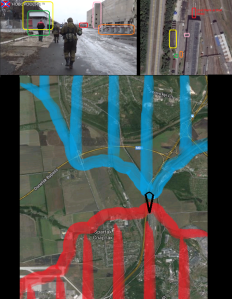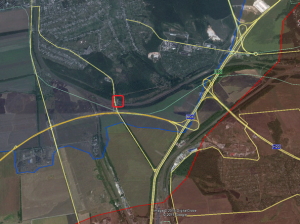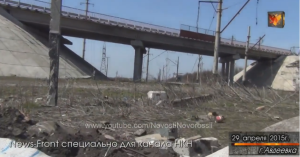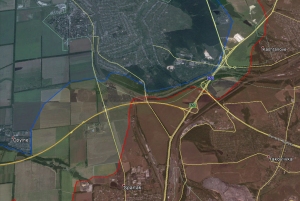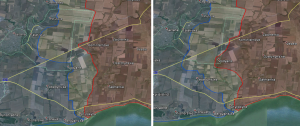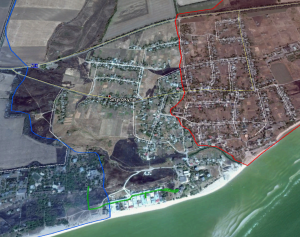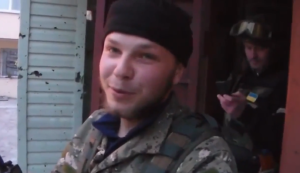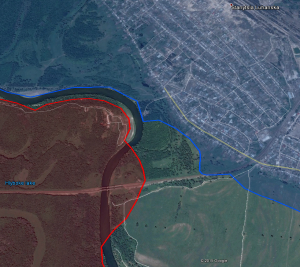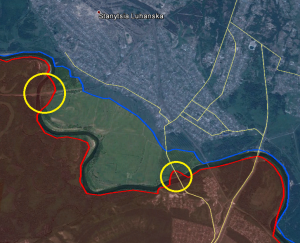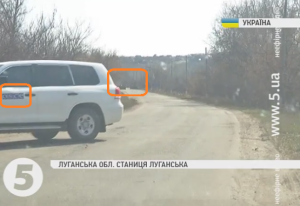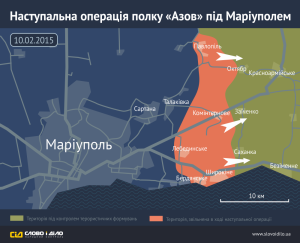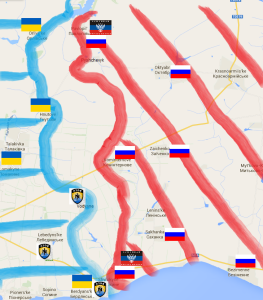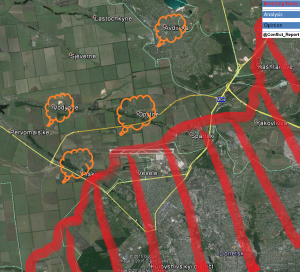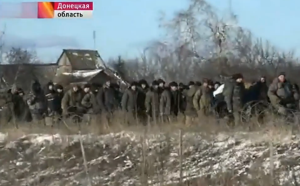During my last trip to Kyiv, Dnipro and Donbas, I’ve been in several closed-door meetings with military staff and international strategists. The following text lists some of my observations and things I was told about realities of the war in Ukraine.
All information was provided under Chatham House Rules, so it is much more straight forward than what you would hear or read from official briefings and politicians’ statements. For the same reason, I won’t name any source, naturally.
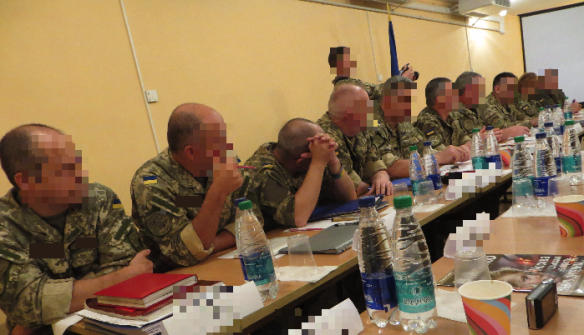
The Ukrainian Army leadership in Donbas
Russian forces and support
Right now, Ukraine faces some 36.300 separatists (most of them Ukrainians) at the front. While 2016 saw around 9.000 Russian troops in eastern Ukraine, this number declined to 3.000. “The problem is that they left their equipment all behind. High tech equipment.” Military academies and (Ukrainian) separatist army training bases work “highly efficient”, some still under Russian army command with many trainers being Russian-trained Ukrainians by now. They are now training “the 3rd generation” of fighters, meaning Russian-trained Ukrainians educate new Ukrainians. Separatist troops are trained on traditional weapons as well as state of the art Russian Army electronic warfare equipment, the invaders left-behind. This results in a well-trained enemy army.
However, over the past months, Russians have reduced logistic and military support in Donetsk and Luhansk. The DNR/LNR military and political leaderships are panicking about this and consider having their own offensive operations against Ukraine, fearing Russia might look for “diplomatic solutions” in which they might cease to exist.
Right now, separatist/Russian forces of the first and second army corps have 478 operational tanks, 848 APCs and 732 artillery pieces inside Ukraine. Approximately the same amount of equipment is located directly on the Russian side of the occupied territories and can be deployed to the territories within less than one day (with Russian soldiers operating most of the weapons systems).

A look into the Ukrainian HQ bunker in Donbas
Technology gap
“Russia is a master of jamming. They don’t need weapons to drown our drones. They jam them”, one officer said. He was asked, who used drones and jamming to counter enemy aerial vehicles. His answer: “Both sides, but they are definitely better than us.”
What the Ukrainian army needs at the front – and hopes to receive from the US – is “night vision equipment, jamming systems, radio intelligence tools and secure communication systems, especially to operate UAVs”.
One quite bold argument why drones must be equipped with night vision and laser targeting equipment was, that Ukraine wants to see where it returns fire. “70% of their artillery and mortar positions are located in close proximity to civilian structures in urban areas. Most of the shelling occurs at night. If we return fire, we would like to see what we hit. This would reduce the risk of hitting civilians.” The officer said that Ukraine must strike back if the pro-Russian fire in violation of Minsk threatens the lives of their forces. They do this almost daily, “endangering our own civilians” (in the occupied areas). They want to change the situation, but need more foreign support to do so.
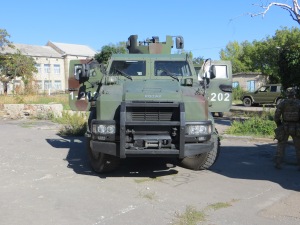
An Ukrainian National Guard “Kozak” armoured vehicle
Separatist war tactics
Some examples of how separatists fight, break the ceasefire and trick the OSCE SMM were given. Around Horlivka, separatist positions sometimes shell each other. “They call them and say, take cover. Then they fire with small arms and both positions ‘return’ fire on us.” Sometimes, separatists fire on their own, sometimes they seem to seek permission from their Russian officers, which are positioned several kilometres behind the front. “This morning, we intercepted their communication. They yelled at their HQ that they were under fire, lying to their officers. We did not fire any shot. Now we wait what the response might be.”
Also, separatists occasionally use entrenched BMP-1 some km from the front as “ballistic weapons”, using their main gun to shell the Ukrainian front “like mortars”. This tactic is used to avoid being spotted by OSCE monitors. It also only very seldomly causes damage or casualties.
Also, the army calls the war tactics of the separatists a “hybrid war”, meaning “propaganda today is the major part in it”. On one day, separatists opened fire 35 times and Ukraine returned fire 8 times. The enemy tenfolded the figure and sent it to the JCCC and the OSCE. “Suddenly we attacked 80 times … “
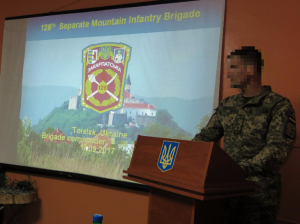 Briefing at the 128th Separate Mountain Infantry Brigade’s HQ in Toretsk
Briefing at the 128th Separate Mountain Infantry Brigade’s HQ in Toretsk
Europe keeps Ukraine’s army small
The European Union, also Germany, deny Ukraine the military support they want, because the EU wants the Ukrainian army “to punch below its fighting weight”. It knows Putin is the aggressor but also has no full trust in Ukraine’s commitment to the Minsk agreement. It fears, nationalist forces could win the upper hand via democratic elections or within the military structure and launch a surprise offensive to regain what belongs to Ukraine in the east.
Some figures within the Ukrainian political and military sphere see this as the only chance as Minsk does not seem to return any square meter to its rightful owner. At the same time, the Ukrainian army feels – and is – much stronger than in 2014 and could throw its weight into the battle to see if it can recapture entire Donbas. However no one thinks that Poroshenko would order such an attack as another defeat would mean the end of his political career. To make sure, nobody in the Ukrainian leadership does, the EU wants Ukraine to remain under-equipped to a certain degree. Also it is afraid that IF Ukraine’s army became a proper opponent to what Russia can send it at any moment, the conflict could spiral out of control.
The Ukrainian army position on the diplomatic initiative is: “Russia suffers under the sanctions, keeping them in place is the only way to eventually solve the conflict due to negotiations”. Some experts think that this implies, lifting the sanctions against Russia could make the Ukrainian government and army turn to “Plan B” as mentioned above.
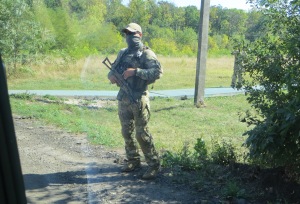
An Ukrainian trooper stands guard near our convoy
Minsk line and the grey zone
Asked about OSCE observations that the Ukrainian army sometimes advances into the grey area, officers made it clear that they regard the – signed also by Russia! – September 19, 2014 contact line as the real one, according to Minsk. This means the army sees advances into the grey zone “to supply our citizens in it” and possibly take new positions as its full right.
The grey zone, meaning points behind what Ukraine holds now but what it regards as on its side of the September 19, 2014 contact lin,e reaches “between 200 meters and 7 kilometres” into not-held territory, sometimes held by separatists, sometimes held by nobody. Thus, it includes “hundreds of settlements” which Ukraine regards as under its protection according to the first Minsk agreement. The army denies that entering these areas violates Minsk and left open, whether it could install permanent positions inside this area. For now, only temporary advances are on the agenda.

Map of Donetsk in the Ukrainian Army HQ in Donbas
Economic downturn risks
While Ukrainian politicians are not really afraid of the country’s recession getting out of control, some foreign experts, living in Kyiv, paint a worst-case scenario. The Euro-Hryvnia exchange rate fell from 1:10 in December 2010 to 1:31 in September 2017. If the Hryvnia fell to between 1:50 or even 1:100, experts fear there could be a mass exodus of Ukrainians to the EU. “You have 5 million people, trying to get into Poland, if that happens”, one expert told me. More millions would try to reach other parts of the EU, traveling via Belarus and Poland to the Baltic states or Romania towards Spain. “Do you want to shoot these people? ‘Cause this is the only way you could stop them in such a stuation”, the expert asked
Russian-speaking people could turn to Russia, fleeing to it or even rise up in the eastern and southern regions, trying to make those areas part of Russia. By the way: All experts agree that Russia is not better off economically, just more successfully creating that image with its propaganda, also received among many “neutral” Ukrainians.
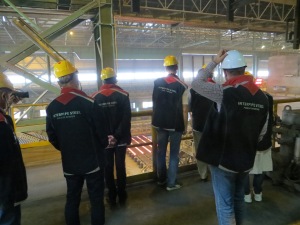
Visit to a steel factory in Dnipro Oblast
Because of all this, economic experts assume that Ukraine is “too big to fail” and must be economically secured at any price. So the fight against the economic downturn is closely connected to the fight against Russia’s hybrid war on the country and the fight against corruption.
Speaking of corruption: One airborne unit commander gave Mr. Rasmussen a “message” to Poroshenko: “Please remind the president of 2014 and the Maidan: If we lose the war against corruption, we not just lose the war in the east, but also all of our state.”

